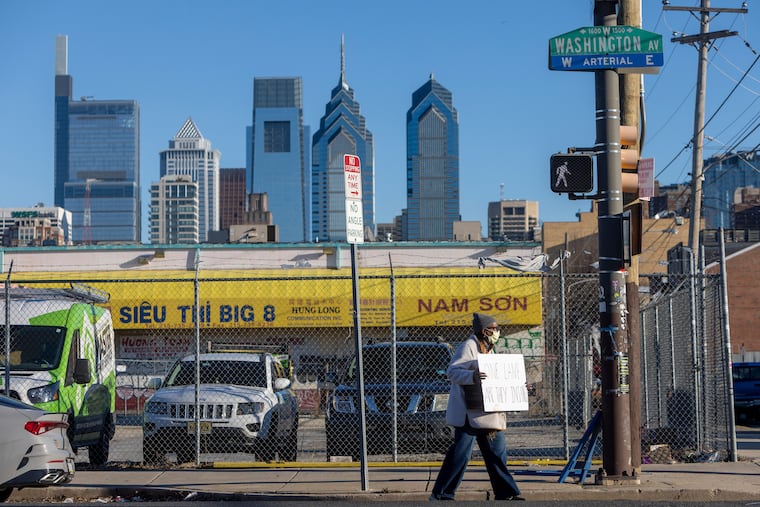It’s time to finally overhaul Washington Avenue | Editorial
The fate of a new proposal for the roadway's redesign may hinge on the support of two City Council members, who have so far failed to take a stand on the plan. It's time for them to do so.

At last, the long saga around the redesign of Washington Avenue appears like it may be over. But is it, though?
The 2.1-mile stretch of roadway in South Philadelphia has been an ongoing concern for city officials since at least 2013, when advocates, businesses, and political leaders began having conversations in earnest about traffic safety and the thoroughfare’s future.
Did it make sense to continue to utilize the avenue, which cuts through a series of increasingly residential neighborhoods, as an industrial highway? Was it possible to make Washington Avenue safer and improve the pedestrian experience while retaining its industrial heritage? Whatever direction city officials decided upon, the competing interests of the various constituencies with a stake in the avenue almost served to guarantee that any proposal would be contentious.
And they were.
» READ MORE: How a redesign of Washington Avenue got detoured by a clash of competing needs
To compensate for the anticipated backlash, the city designed an extraordinarily wide-ranging public outreach process, which went beyond the usual visits with community groups. Officials unfurled a campaign to reach the general public with detailed presentations, explainer videos, and a survey that more than 5,000 residents completed.
Afterward, the city released a proposal that it labeled the “final design” that would make the avenue safer by reducing it from five lanes to three lanes.
But “final” didn’t turn out to be so final after all.
Despite an extensive response, the city’s outreach efforts were deemed insufficient and officials said last month that the three-lane plan would be scuttled.
This board expressed its dismay at the city’s decision to forsake an effective and popular plan in what seemed to be an effort to reach a predetermined outcome.
Last week, however, the nearly decade-long debate seemed to be approaching its conclusion (again) when city officials unveiled their latest recommendation, a version with increased safety features to satisfy complaints about dangerous driving on both Washington Avenue and some of the nearby side streets.
Much of the avenue — long part of the city’s high injury network, the 12% of streets where 50% of traffic deaths and severe injuries occur — would see traffic patterns reduced to three lanes. There were also plans for protected bicycle lanes, new loading zones, and more parking spaces.
While the newly announced proposal was not what some street safety advocates hoped for — parts of the avenue nearest Broad Street, for example, will stay at five or four lanes — one could be forgiven for thinking the saga was over. Particularly since the administration of Mayor Jim Kenney has described the new plan as its final recommendation.
The fate of the proposal may hinge, though, on the endorsement of Councilmembers Mark Squilla and Kenyatta Johnson, whose districts encompass much of Washington Avenue.
Despite the mayor’s endorsement, neither member of Council has been willing to publicly commit to supporting or opposing the plan. Neither has expressed an opinion about implementing the new parking regulations that city officials have described as a requirement for the redesign, with Johnson telling reporters that he was looking forward to more conversations and feedback around the issue and suggesting that further revisions might be necessary for the proposal.
» READ MORE: Washington Avenue will vary between 3 and 5 lanes under latest redesign
He might be the only person in Philadelphia who feels that way. After nearly 10 years of discussion, what is left to say?
While few people may be thrilled with the compromise that transportation officials devised, the city’s Deputy Managing Director Michael Carroll was correct when he told the audience at the community meeting where the new plan was unveiled that the avenue’s current condition is actively hazardous and untenable going forward.
With the spring paving season approaching, it is time to finally end this debate and build a Washington Avenue that is significantly safer than the status quo. Unfortunately, making that happen relies on Squilla and Johnson doing something that they have so far avoided, which is taking a public position on how best to move forward. The new plan for Washington Avenue, which should reduce accidents by trimming down lanes and providing much-needed parking and loading zone options, is worthy of their support.
Throughout the redesign proposal process, both Squilla and Johnson have said that they want to take everyone’s concerns about Washington Avenue seriously, but at this point, both men have had years to make up their minds. For the safety of everyone who uses the avenue, it is time that they do so.